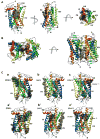Role of membrane integrity on G protein-coupled receptors: Rhodopsin stability and function
- PMID: 21435354
- PMCID: PMC3114187
- DOI: 10.1016/j.plipres.2011.03.002
Role of membrane integrity on G protein-coupled receptors: Rhodopsin stability and function
Abstract
Rhodopsin is a prototypical G protein-coupled receptor (GPCR) - a member of the superfamily that shares a similar structural architecture consisting of seven-transmembrane helices and propagates various signals across biological membranes. Rhodopsin is embedded in the lipid bilayer of specialized disk membranes in the outer segments of retinal rod photoreceptor cells where it transmits a light-stimulated signal. Photoactivated rhodopsin then activates a visual signaling cascade through its cognate G protein, transducin or Gt, that results in a neuronal response in the brain. Interestingly, the lipid composition of ROS membranes not only differs from that of the photoreceptor plasma membrane but is critical for visual transduction. Specifically, lipids can modulate structural changes in rhodopsin that occur after photoactivation and influence binding of transducin. Thus, altering the lipid organization of ROS membranes can result in visual dysfunction and blindness.
Published by Elsevier Ltd.
Figures





References
-
- Jacobson K, Mouritsen OG, Anderson RG. Lipid rafts: at a crossroad between cell biology and physics. Nat Cell Biol. 2007;9:7–14. - PubMed
-
- Smith SO. Structure and activation of the visual pigment rhodopsin. Annu Rev Biophys. 2010;39:309–328. - PubMed
-
- Aveldano MI. Phospholipid solubilization during detergent extraction of rhodopsin from photoreceptor disk membranes. Arch Biochem Biophys. 1995;324:331–343. - PubMed
Publication types
MeSH terms
Substances
Grants and funding
LinkOut - more resources
Full Text Sources
Miscellaneous

